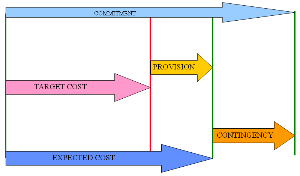Risk management - Clarification of terms
Clarification of terms
Understanding the significance of these terms and how they are derived is central to the RISK MANAGEMENT PROCESS.
Expected cost
The ‘expected cost’ is precisely that. It is the cost of the project if all goes to plan. This will include all identified risks which we expect to occur and thus have been allowed for within the management of the plan. Let us say that this is £180,000. The likelihood of meeting the expected cost may be 50 to 60%.
ContingencyFor those risks that could have a significant impact on the project that we hope do not, but may occur, we need to have contingency funds.
With the additional funds for contingency the chance for success is increased to around 80 to 90%.
From the project manager’s perspective, if it is difficult to go to the board for extra funds should things go wrong, the project manager is likely to increase the contingency at the outset.
For example, a particular risk may require £100,000 to implement the contingency plan.
However, there may be likelihood of it occurring = 50%.
The amount allowed in the budget will be £100,000 x 50% = £50,000.
Should the risk materialise the project manager would have £50,000 available and need to find another £50,000. This may be tricky.
Hence, if reputations are on the line, the project manager may be unwilling to accept the risk of 50% and want it higher say 70%.
In this case, there will be £70,000 available. The shortfall of £30,000 will be easier to find amongst the total contingency.
The overall potential cost of a project may be £200,000 of which £180,000 is the expected cost and the other £20,000 is contingency.
However, the project manager may set a ‘target’ of less than £180,000 and retain say £25,000 as a ‘provision’.
This is the target set by the board in order to ‘challenge’ the project team to manage the project as efficiently as possible.
Typically these may have up to about a 50% chance of being achieved.
If the amount of money released was equal to the ‘expected cost’ it is likely that if things were going well that work would expand to fill the time available.
This is the amount of funds ‘held back’ by the board as the difference between the ‘expected cost’ and the ‘target cost’.
CommitmentsThe sum of the ‘expected cost’ and the ‘contingency’ is a measure of the ‘commitment’ of senior managers to the project.
Where do these figures come from?
They could be plucked out of the air or based upon limited data.
However, the use of a RISK MANAGEMENT PROCESS allows us to derive figures for these values based upon the risk we are willing to accept.



